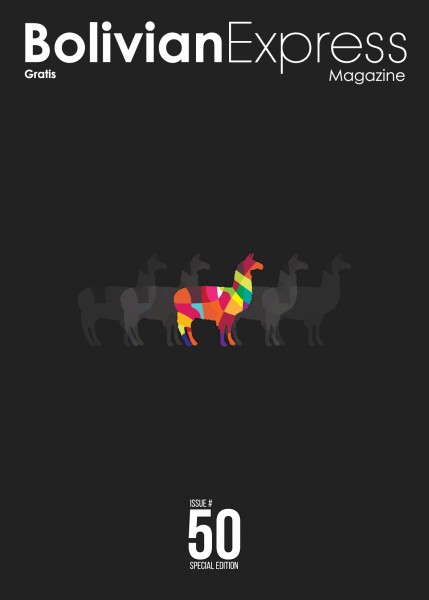
Five years ago Bolivian Express was born between a japanese restaurant and a lift on Avenida 20 de Octubre in La Paz. During the clunky journey from the ground floor to the 17th storey, two young gentlemen and a Swiss-Indian chica lamented the absence of an English-language publication in the country; two notable predecessors—the Bolivian Times and Llama Express—were sadly no longer in circulation. And so the name of the magazine was born as a portmanteau of sorts, an homage to the magazine’s forebearers.
We were determined to find a viable way of printing a quality free publication, given the erratic nature of local advertising revenues and shortage of local English-language journalists. A further (Irish) founder was enlisted and six university friends were boarded on a plane, kidnapped to serve as editorial guinea pigs. It became clear to the founding team that an ideal way of sustaining the project as a whole would be to combine it with a journalism training programme.
What started off as a magazine for tourists quickly turned into something else. After the first 10 issues, we had already covered all the well-trodden festivities and attractions the country is probably best known for. The continuous challenge has been to find new stories from which everyone, including the local audience, can learn something new. Indeed, over half of our readers are native Spanish speakers, so we are as committed to writing for them as we are for the uninitiated in Bolivia. This work has brought us close to people we would perhaps never have had an excuse to get to know: from former presidents, ministers and local sporting heroes, to Michael Jackson impersonators, prisoners serving life sentences and private investigators.
Since our unconventional beginnings, the project has involved over 120 people from 20+ countries worldwide who have come to volunteer as part of the effort.Today, the Bolivian Express team of volunteers live and sleep in a shared house as they explore the country, its stories and cultures with the help of a local team. By looking beyond the salt-flats and ancient ruins, their mission is to bring new eyes to this infinite land. If they leave as cultural ambassadors, rather than just tourists, the project has achieved one of its aims. And, of course, by flicking through these pages you, the reader, are closing the circle and helping to complete this project’s mission.
Over the years we have also worked with a large number of people across the world: editors scattered across San Francisco, New York and Caracas, a web developer in Berlin, an editor and marketing director somewhere in the Swiss alps, and even a virtual assistant in Bulgaria (hey, Pavlin). As past team members have taken on new challenges, others have appeared and have reshaped the project anew. With this, our 50th issue, we are incredibly proud to say that Bolivian Express has a life of its own; it exists as something greater and wiser than the people who have made it possible so far.
Thank you for being a part of this journey.
PHOTO: IVAN RODRIGUEZ PETKOVIC
The family that has stolen the hearts of every paceño (especially those who live in the Zona Sur) can still be seen performing its arduous juggling act on Avenida Costanera and its surroundings. Over time, this unique family has gained recognition from city dwellers, who understand that the only thing the family seeks with its trade is to make a living
Paceños tend to empathize more with the family than with foreign jugglers or other street artists, the majority of whom are Colombian or Argentinian. When the initial 'Chicken Jugglers' article was published in BX, it tried to raise awareness of this family's story among our middle and upper class readers and emphasize how they represent a clear example of the precarious work situation faced by many Bolivians.
PHOTO: IVAN RODRIGUEZ PETKOVIC
One of the most striking characteristics of La Paz, emerging from the depths of informal labour, is the artistic display of informal shows that take place in the centre of town, around the San Francisco church. This area of the city is crucial and strategic for the daily commute of thousands of people and tourists who swarm this part of town.
Due to the affluence of commuters,many paceño characters gather here to perform and entertain the passing public every night during rush hour (between 6pm and 10pm). Among these characters is the 16-year-old Gonzalo Mamani, who brings the legendary Michael Jackson back to life, with his faultless impersonation of the deceased singer. Gonzalo never falters to dazzle the crowd with each of his dance moves, both on an artistic level and on a personal one, given that he is just a young boy trying to make a living.
It remains clear in my mind: the memory of the day I first entered Layka Restaurant on Linares street. More clear yet rests the mental image, burnt into my retina, of the first thing that you see upon entering this picturesque establishment: an antithetical mural of the Last Supper, representing the devil and his minions having a feast in hell. Without a doubt, this left me a bit unnerved at first and shaken.
It was precisely at Layka where I had the chance to drink one of the most exotic and eccentric drinks I have ever tried: singani distilled with the body of a real-life viper. According to Mauricio, the producer of this drink (who also happens to be the owner of the restaurant) he placed the live animal into the drink himself in order for the snake to absorb and distill the singani. It was one of the best singanis I have drunk in my entire life. The tale of how it was produced, made the taste transcendental.

 Download
Download





















